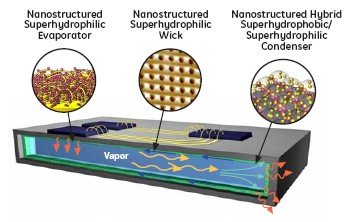The material will be used for military applications, it's unknown if it will be cheap enough to reach the mass market.
The substrate utilizes phase-change-based heat transfer, but GE is rather tight-lipped about the technology. It is known that it is based on "unique surface engineered coatings" that both repel and attract water, in particular. It features nano hydrophilic evaporator, which "attracts" cool water and quickly turns it into vapor; nano hydrophilic wick, which absorbs cool water and lets vapor through to a hybrid hydrophobic/hydrophilic condenser, which turns vapor back into water and "sends" it through the wick back to the evaporator. While the process is pretty natural, special structures designed by GE let it flow far more quickly than in case of other materials. Production cost of the material is unclear.
“In demonstrations, GE’s prototype substrate has functioned effectively in a variety of electronics application environments. We also subjected it to harsh conditions during testing and found it could successfully operate in extremely high gravity applications," said Dr. Tao Deng, a senior scientist at GE global research and the project leader.

Source: X-bit Labs